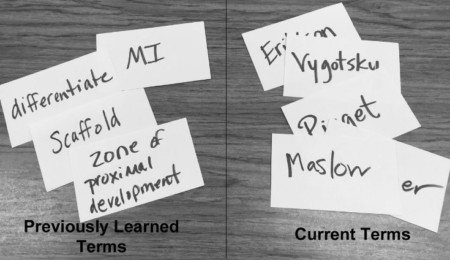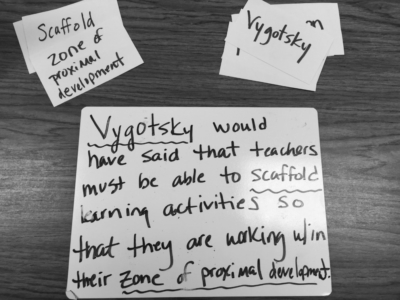Connected Cards is part five in an eight-part series on e-learning technical vocabulary systems. Read part one, part two, part three and part four.
Metacognition is an amazing force in classroom instruction. When we compel students to think about their own thinking, they learn to reflect more deeply. Momentum grows as they begin to work cooperatively with peers. Conversations are driven by purposeful dialogue. Coupled with the experiential nature of career and technical education (CTE) — learn by doing — we find innovative ways to encourage literacy learning.
But… how, while remote learning, do CTE teachers engage students in the productive talk needed to process technical vocabulary terms?
A possible solution
Plan strategically to encourage productive talk during online instructional sessions. With the use of the connected cards strategy, students learn to speak up, to take on an active role in the lesson. Rather than making occasional participation requests, create the expectation of continual talk and discussion. Pause to highlight a term or concept in any given lesson; then challenge students to make a connection with a previously learned term. As each student takes a turn, dialogue increases naturally. It becomes the essence of productive talk. The power in this approach lies here: Students have opportunities to examine the relationship between multiple terms, over multiple units.

Connected Cards
Gist: A game a bit like Apples to Apples, in which students must find a way to connect a previously learned term with a random term from the current lesson
When to use: To help students connect new learning to previously learned information. Also as test preparation, when terms have been covered but students need to practice

How It Works
- Write several previously learned vocabulary terms on a set of notecards. Create a second set of notecards with terms the students are learning currently. (Scaffolding Note: If you wish to emphasize definitions, include those on the backs of the cards.) Instruct students to create their own sets of cards.
- When the remote learning session begins, identify two students who will go first. Ask one student to pull a card from their stack of new terms. The other selects a card from previously learned terms.
- Say, “Students, converse about these terms.” The expectation is they will work together to reflect on their learned experience and make connections. Invariably, their classmates will think of the connections they themselves would make.
- The rest of the students give a thumbs up if the interaction created a memorable way to understand the new term. Majority rules. If most thumbs are up, the two students who made the connection each get a point.
- Remind students during play that this game is not about placing the word itself into its proper category. Instead, it is about finding a clever way to connect what they’ve learned in one category to what they’ve learned in another.
- Repeat until all students have participated in pairs.
A student’s perspective
“This game is a real challenge, but it’s fun! Using the new terms in a sentence about something I already know helps me remember.”
See the strategy in action.
Sandra Adams is a teacher and instructional coach with the Career Academy, Fort Wayne Community Schools. She co-wrote the ACTE-supported book But I’m NOT a Reading Teacher!: Literacy Strategies for Career and Technical Educators with Gwendolyn Leininger, where further detailed explanations of the strategies in this series can be found. Email her.






